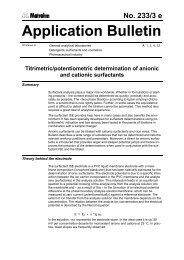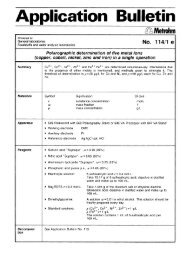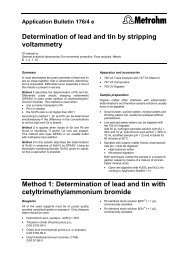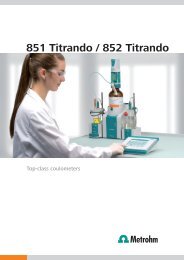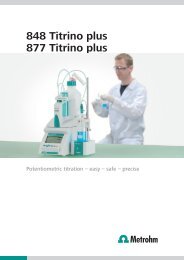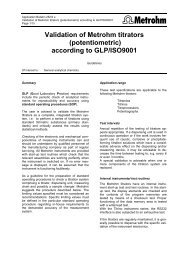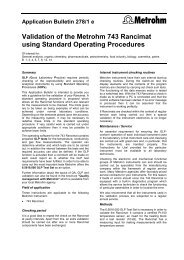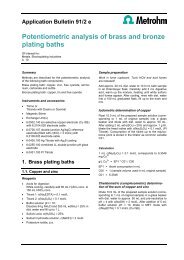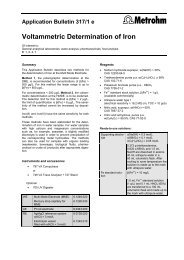Download (PDF) - Metrohm
Download (PDF) - Metrohm
Download (PDF) - Metrohm
You also want an ePaper? Increase the reach of your titles
YUMPU automatically turns print PDFs into web optimized ePapers that Google loves.
Literature referencesLiterature referencesWhile we are pleased to be able to offeryou this literature service, we are not ina position to provide you with photocopiesof the original references simply forcopyright reasons. Normally, you canhave copies made of any reference thatinterests you at your nearest universitylibrary and usually at a favorable price.Thank you for your understanding in thismatter.Literature references polarography/voltammetry• Copper, nickel and vanadium in the Western Galician Shelf in early springafter the Prestige catastrophe: Is there seawater contamination?Juan Santos-Echeandía, Ricardo Prego, Antonio Cobelo-GarcíaThe original cargo fuel transported by the Prestige tanker contained, accordingto our analysis, several trace elements, for example Cu (3 µg g –1 ), Ni (97 µg g –1 )and V (382 µg g –1 ). The possibility of metal contamination of seawater near thebottom by the sedimented fuel and in surface waters by the fuel deposited onthe littoral area was investigated in the Western Galician Shelf five months afterthe Prestige shipwreck (November 2002). Water samples taken at eight stationsfrom Finisterre Cape to Miño River were analyzed by means of an electroanalyticalmethod (AdCSV) following trace metal clean procedures. Only the surfaceCu and Ni concentrations at the Ons and Cíes Islands were higher than thoseconsidered as background for open North-East Atlantic Ocean waters. The accumulationand weathering of the fuel deposited on the shores could be a significantsource for the enrichment found, but the influence of industrial and urbaninputs from the neighboring Pontevedra and Vigo estuaries is also possible.Thus, this study was useful for establishing typical values of Cu, Ni and V in GalicianShelf waters for the first time. Total metal concentrations ranged between1.7 and 3.4 nmol L –1 for Cu, between 2.9 and 4.8 nmol L –1 for Ni and between19.7 and 32.3 nmol L –1 for V; dissolved concentrations were between 0.7 and1.5 nmol L –1 for Cu, between 2.2 and 3.3 nmol L –1 for Ni and between 15.5 and27.0 nmol L –1 for V; particulate values below 2.6 nmol L –1 for Cu, 2 nmol L –1 forNi and 7.2 nmol L –1 for V were obtained.Anal. Bioanal. Chem. 382 (2005) 360–365• Determination of platinum with thiosemicarbazide by catalytic adsorptivestripping voltammetry (AdSV)Sylwester Huszal, Joanna Kowalska, Magdalena Krzeminska, Jerzy GolimowskiThis work describes a very sensitive and selective voltammetric procedure forthe determination of platinum. Instead of the commonly used hydrazine, thiosemicarbazideas a component of the supporting electrolyte was applied. Themethod is based on the adsorption of the platinum-thiosemicarbazone complex,formed in situ in the voltammetric cell from thiosemicarbazide and formaldehyde,coupled with a hydrogen catalytic reaction at a hanging mercury dropelectrode. The linear relation between the platinum concentration and the heightof the analytical signal was observed up to 1.5 × 10 –9 mol L –1 with the detectionlimit calculated as 1.5 × 10 –13 mol L –1 (3 s of the blank) after 50 s of accumulationtime. The effect of various interferences from other ions was studied. Thedescribed method was applied to the determination of platinum in hydroponicallycultivated plants after microwave decomposition.Electroanalysis 17/4 (2005) 299–304• Highly selective adsorptive cathodic stripping voltammetric determination ofuranium in the presence of pyromellitic acidM. B. Gholivand, H. Rashidi NassabA very sensitive and selective adsorptive cathodic stripping procedure for tracemeasurement of uranium is presented. The method is based on adsorptiveaccumulation of the uranium-pyromellitic acid (benzene-1,2,4,5-tetracarboxylicacid) complex onto a hanging mercury drop electrode, followed by reductionof the adsorbed species by voltammetric scan using differential pulse modulation.Influences of effective parameters such as pH value, concentration of30 <strong>Metrohm</strong> Information Issue 2/2005





